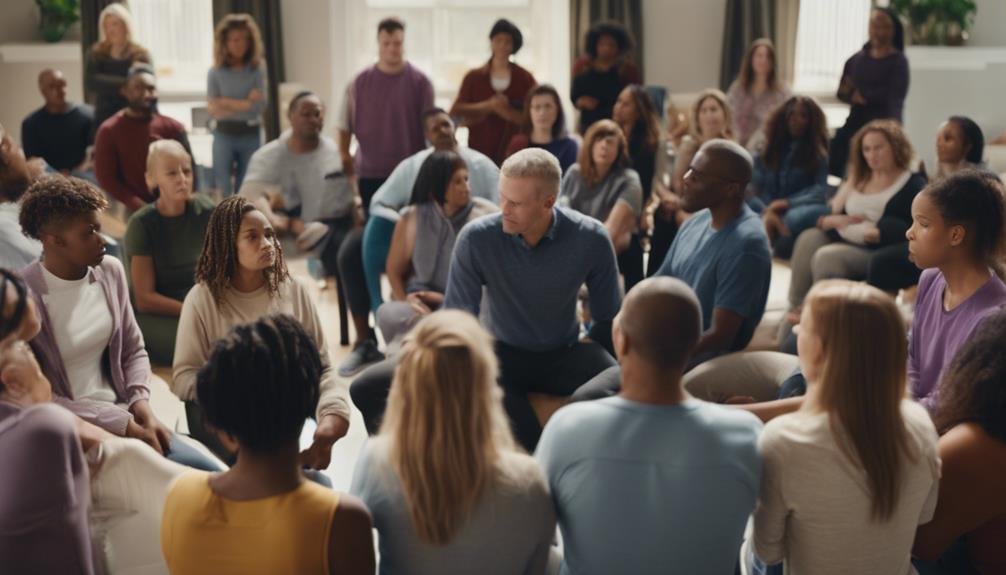Empower your community to combat domestic violence effectively with our ten essential tips. Engage key stakeholders and involve survivors from the start. Collaborate with various groups for tailored strategies. Educate on healthy relationships and warning signs. Provide resources, toolkits, and training for skill-building. Foster effective communication and challenge harmful norms. Prioritize safety, well-being, and survivor empowerment. Advocate for policy changes and create safe spaces. By prioritizing these steps, you lay a strong foundation for successful community-led prevention programs.
Key Takeaways
- Engage key stakeholders and survivors in program planning.
- Foster collaboration among diverse community members and organizations.
- Customize prevention strategies through partnerships and community resources.
- Provide education on healthy relationships and warning signs.
- Empower communities with resources, tools, and support networks.
Engage Key Stakeholders
How can you effectively engage key stakeholders in community-led domestic violence prevention programs?
Community engagement is vital in creating successful prevention initiatives. Start by reaching out to community members, leaders, and organizations to build a network of support. By involving a diverse range of stakeholders, such as local agencies, schools, healthcare providers, and law enforcement, you can create a thorough approach to prevention.
It is essential to include survivors of domestic violence in the planning and implementation of programs. Their voices must be heard to address their specific needs effectively. Seek input from various community groups to customize prevention strategies for different populations, ensuring inclusivity and relevance.
Additionally, establish partnerships with faith-based organizations, businesses, and civic groups to broaden the impact of your prevention efforts. By collaborating with a wide range of stakeholders, you can harness the collective power of the community to combat domestic violence effectively.
Promote Community Collaboration
To promote effective community collaboration in domestic violence prevention programs, engage local stakeholders, organizations, and residents in planning and implementing strategies.
Collaborative efforts can greatly enhance the impact and sustainability of prevention initiatives by tapping into diverse community resources and expertise. By forging partnerships with key community members, you can tailor prevention efforts to address specific needs and challenges in different neighborhoods or populations.
Actively involving community members not only fosters a sense of ownership but also instills a shared responsibility in creating safer environments for all. Cultivating a culture of collaboration and mutual support within the community can lead to lasting positive changes in attitudes, behaviors, and social norms related to domestic violence prevention.
Provide Education on Healthy Relationships
Engaging in educational initiatives on healthy relationships equips individuals with the knowledge and skills to recognize and prevent domestic violence. By providing education on healthy relationships, you empower community members to cultivate positive dynamics that reduce the risk of violence.
Teaching about the warning signs of unhealthy relationships is essential as it enables individuals to identify red flags early and seek help when needed. These educational initiatives not only increase awareness about the impact of domestic violence on individuals and society but also create a foundation for building healthier communities.
Through education on healthy relationships, you’re laying the groundwork for fostering well-being within your community. By equipping individuals with the necessary tools and knowledge, you’re actively contributing to the prevention of domestic violence.
Empower Through Resources and Tools
Empowering communities through accessible resources and practical tools is pivotal in the fight against domestic violence. By providing toolkits, training materials, and educational resources, you can equip individuals with the knowledge and skills needed to prevent domestic violence.
Offering access to online platforms, webinars, and workshops for skill-building and knowledge-sharing can further enhance community members’ ability to recognize, prevent, and respond to domestic violence effectively. Additionally, by arming community leaders with the necessary resources to mobilize and engage their communities, you can foster a supportive environment for prevention efforts.
Supporting community-led initiatives with practical guides, manuals, and best practices for prevention programs can have a substantial impact on the success of your initiatives. Remember, by empowering communities through these resources and tools, you’re taking proactive steps towards preventing domestic violence and creating safer, healthier environments for all individuals.
Foster Effective Communication Skills

Developing strong communication skills is essential for fostering trust and collaboration within your community. When engaging in community mobilization for domestic violence prevention, effective communication plays a pivotal role in creating a supportive and inclusive environment. By practicing clear and respectful communication, you can encourage active engagement and participation from community members, making them feel valued and heard in the prevention efforts.
Listening attentively to the concerns and feedback of individuals within the community is key to establishing an open dialogue where everyone’s voice is acknowledged. Providing platforms for community members to share their thoughts and ideas not only enhances collaboration but also promotes effective problem-solving strategies.
Encourage Conflict Resolution Strategies
Promoting conflict resolution strategies is vital in building healthier communication habits and preventing violence in your community.
By advocating for healthy communication and teaching de-escalation techniques, you can empower individuals to address conflicts peacefully and prevent them from escalating into harmful situations.
Emphasizing these strategies equips community members with the necessary tools to navigate disputes constructively, fostering safer environments and promoting positive relationships among individuals.
Promote Healthy Communication
To promote healthy communication and encourage conflict resolution strategies, prioritize fostering understanding and respect among individuals in relationships. By actively listening to one another and expressing thoughts and feelings openly, you can create a foundation for effective communication.
Prevention efforts in domestic violence focus on building strong communication skills to reduce the likelihood of conflicts escalating into harmful situations. Encouraging individuals to address disagreements constructively empowers them to navigate challenging situations without resorting to violence.
Healthy communication not only helps prevent misunderstandings but also promotes healthy relationships within communities. Creating a safe space for open dialogue and respectful conversations can greatly contribute to preventing conflicts from turning into violence.
Teach De-Escalation Techniques
Create a foundation for peaceful interactions and conflict resolution by equipping individuals with de-escalation techniques to manage conflicts safely and prevent violence.
De-escalation strategies are invaluable in diffusing tense situations and fostering effective communication to prevent conflicts from escalating into violence. Training in de-escalation empowers individuals with skills like active listening, empathy, and problem-solving, enabling them to navigate conflicts without resorting to harmful behaviors.
By promoting these techniques within community-led programs, individuals can learn to handle disagreements in a non-violent manner, ultimately contributing to a safer and more harmonious environment for all.
Encouraging the use of de-escalation techniques not only enhances personal relationships but also plays an essential role in preventing potential acts of violence. By embracing these conflict resolution strategies, individuals can cultivate a culture of understanding and respect, paving the way for healthier interactions and a violence-free community.
Address Gender Equality

Promoting gender equality within domestic violence prevention programs is essential for dismantling harmful power dynamics and fostering a culture of respect and equity. By addressing gender inequality, you empower individuals to recognize and resist oppressive norms that perpetuate domestic violence.
Programs that focus on gender equality not only aim to reduce domestic violence incidents but also aim to create a more equitable and respectful society for all. Challenging gender stereotypes is vital in shifting attitudes and behaviors related to domestic violence, as these deeply ingrained beliefs can contribute to the perpetuation of abusive behaviors.
Emphasizing gender equality in your prevention efforts can lead to transformative change within communities, breaking down barriers that uphold unequal power dynamics and promoting healthier relationships based on mutual respect and understanding. Start by promoting discussions and initiatives that promote gender equality to create a safer and more inclusive environment for everyone.
Challenge Harmful Norms
Challenge the harmful norms that perpetuate domestic violence by actively engaging community members in critical conversations and awareness-building initiatives.
Social norms play a significant role in shaping behaviors and attitudes within communities, influencing how individuals perceive and respond to domestic violence. By addressing these harmful norms head-on, community-led domestic violence prevention programs aim to create a culture that values respect, equality, and non-violence.
Educating community members about the impact of these detrimental social norms is essential in preventing domestic violence. Through workshops, discussions, and awareness campaigns, individuals can gain a deeper understanding of how these norms contribute to harmful behaviors and attitudes.
Empowering community members to challenge and change these norms is a key focus of community-led initiatives, fostering a sense of agency and responsibility in combating domestic violence at its roots.
Build Resilient Communities

You play a crucial role in fostering community connections that create a safe and supportive environment.
Empower individuals within your community to take proactive steps in preventing domestic violence.
Strengthen support networks to guarantee everyone has the resources they need to challenge harmful norms and promote accountability.
Foster Community Connections
Building resilient communities through fostering connections is an essential step in preventing domestic violence and creating a safe environment for all community members. Community connections play an important role in promoting support networks, raising awareness, and providing resources to effectively prevent and address domestic violence.
By enhancing social cohesion, communities become better equipped to challenge harmful social norms, advocate for policy changes, and offer essential support to survivors.
Strengthening community bonds empowers individuals to take action against domestic violence, fostering a culture of safety and support within the community. These connections are critical for sustainable prevention efforts and lay the groundwork for long-term change in tackling domestic violence effectively.
Promote Empowerment Within
Empower individuals, families, and neighborhoods by promoting resilience and fostering connections within your community to effectively prevent and respond to domestic violence. Building resilient communities is key to promoting empowerment within.
By implementing strategies that foster leadership, build social networks, and promote community cohesion, you can create a supportive environment where individuals feel empowered to speak out against violence and support survivors.
Resilient communities have the capacity to challenge harmful norms, advocate for change, and provide essential support to those affected by domestic violence. Through community-led prevention programs, you can focus on strengthening community assets and promoting community accountability.
Strengthen Support Networks
To effectively prevent domestic violence, fostering strong support networks is essential in building resilient communities. By strengthening social connections and community bonds, individuals at risk can experience enhanced well-being and a sense of belonging.
Creating safe spaces within the community for survivors to access support and resources is vital in empowering them to seek help and break free from abusive situations.
Mobilizing communities to provide ongoing support and resources greatly increases the effectiveness of domestic violence prevention efforts. By developing programs that focus on building relationships and fostering a sense of community, we can proactively address the root causes of violence and promote healthy, respectful interactions.
Prioritize Safety and Well-being
Ensuring the safety and well-being of survivors is paramount in any community-led domestic violence prevention program. Prevention efforts must focus on immediate safety measures for survivors while also addressing their overall well-being.
Creating safe spaces where survivors feel supported and providing accessible resources are pivotal components of effective prevention strategies.
Educating communities about recognizing warning signs and advocating for policy changes are essential for enhancing safety and preventing domestic violence.
Frequently Asked Questions
What Are Community Strategies for Preventing Violence?
Engage your community deeply in preventing violence. Targeting individuals, communities, and society is key. Educate, build support, challenge norms. Mobilize groups for accountability. Strengthen networks, develop leaders, transform structures. Together, make a difference in ending domestic violence.
What Are the 5 Ways to Prevent Violence in the Society?
To prevent violence in society, start by promoting awareness through media campaigns. Educate on warning signs, foster strong support systems, challenge harmful norms, and empower community action. Strengthen assets and leadership for lasting change.
What Are Four 4 Ways to Reduce Youth Violence?
To reduce youth violence, focus on youth empowerment. Engage them in positive activities, offer mentorship, provide mental health services, and teach conflict resolution. Strengthen community-police relationships. Address root causes like poverty. Together, we can make a difference.
What Do Violence Prevention Programs Do?
Violence prevention programs engage individuals, communities, and society to prevent domestic violence. By educating, building support, and organizing, these programs aim to challenge norms, promote accountability, and strengthen networks. Impact evaluation measures the effectiveness of these efforts.
Conclusion
To wrap up, keep in mind that small steps can lead to big changes in preventing domestic violence in your community. By engaging key stakeholders, promoting collaboration, and educating on healthy relationships, you can create a safer environment for everyone.
So, go forth and be the superhero your community needs – because even the tiniest ripple can create a tsunami of positive impact. Together, we can make a difference.







